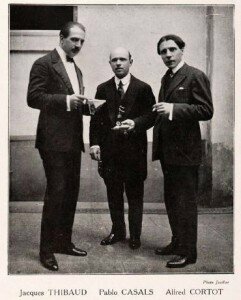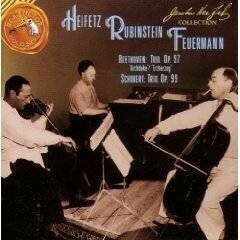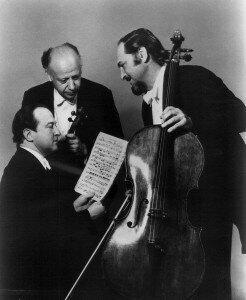
Cortot-Thibaud-Casals Trio

The First Million Dollar Trio
Beethoven: Piano Trio No. 7 in B-Flat Major, Op. 97, “Archduke”: I. Allegro moderato (Alfred Cortot, piano; Jacques Thibaud, violin; Pablo Casals, cello)
The first so-called Million-Dollar Trio of Arthur Rubinstein (piano), Jascha Heifetz (violin), and Emanuel Feuermann (cello), formed in 1941, and a later one, with the same nickname, was made up of Arthur Rubinstein (piano), Jascha Heifetz (violin), and Gregor Piatigorsky. The name came from the fact that the three players (no matter what combination) were the most famous soloists of their day. Feuermann so hated the nickname that he exited the trio very quickly after it was applied. The first trio played trios of Beethoven, Schubert and Brahms, while the second trio played more works by modern composers such as Mendelssohn, Tchaikovsky, and Ravel.
Beethoven: Piano Trio No. 7 in B-Flat Major, Op. 97, “Archduke”: II. Scherzo: Allegro (Jascha Heifetz, violin; Emanuel Feuermann, cello; Arthur Rubinstein, piano)
Heifetz – Piatigorsky – Rubinstein
Schubert – Piano Trio in B-flat (1st movement)

The Beaux Arts Trio
Beethoven: Piano Trio No. 7 in B-Flat Major, Op. 97, “Archduke”: III. Andante cantabile ma pero con moto (Beaux Arts Trio)
The Beaux Arts Trio was able to record the entirety of the Piano Trio repertoire and on what would have been their 60th anniversary in 2015, Decca Classics issued a 60-CD box set of their recordings.
Eugene Istomin (piano), Isaac Stern (violin), and Leonard Rose (cello) formed the Istomin-Stern-Rose Trio in 1961. They also focused on the music of Beethoven, Brahms, and Schubert and their Beethoven recording won a Grammy Award in 1960.

Istomin-Stern-Rose Trio
The Ax-Kim-Ma Trio formed in 1983, consisting of Young Uck Kim on violin, Yo-Yo Ma on cello, and Emanuel Ax on piano. While Ma and Ax knew each other from Juilliard, Kim studied at the Curtis Institute in Philadelphia. Their 1988 recording of Dvořák’s trios was an award-winner.
Dvořák: Piano Trio No. 3 in F Minor, Op. 65: I. Allegro ma non troppo (Young Uck Kim, violin; Yo-Yo Ma, cello; Emanuel Ax, piano)
Other famous trios have gotten together, such as Daniel Barenboim, Pinchas Zukerman, and Jacqueline du Pré; Wilhelm Kempff, Henryk Szeryng, and Pierre Fournier; Vladimir Ashkenazy, Itzhak Perlman, and Lynn Harrell to list just a few of the more familiar ones. The individual artists, when combined together with music that is designed to show their strengths, have created ensembles that transcend each members’ personal fame to give us a new reason for that fame.

